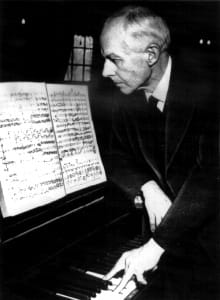- Gathering Note
- Posts
- Mandarin and Lousadzak featured by Seattle Symphony and Dennis Russell Davies
Mandarin and Lousadzak featured by Seattle Symphony and Dennis Russell Davies

Like Bluebeard’s Castle – which was performed earlier in the year by the Seattle Opera – Bartok’s Miraculous Mandarin is a musical setting of love with ghastly consequences. The Miraculous Mandarin was paired with Alan Hovhaness’s Lousadzak, a concerto for piano and strings. The pieces were the focal point of Dennis Russell Davies first concert with the Seattle Symphony during his two week stay with the orchestra.
The tale of the Miraculous Mandarin revolves around a woman. In this case, a woman who is being held captive and used as a decoy for a group of thieves. The thieves set up their operation in a badly appointed room located in the slums of a city. The thieves force the woman to sit seductively in the window of the room and draw in suitors who the thieves will rob. At first these criminal efforts aren’t successful. Patrons come, but they are forced away because they are poor.
It is only when a strangely dressed man with East Asian origins eyes the woman that the thieves finally find someone worth seeing their ploy through to the end. Except, the Mandarin proves to be a hard target. First the woman rejects his icy advance then the thieves attack, stabbing him, but he doesn’t die. Instead, he stays fixated on the woman. Relenting, the woman embraces the Mandarin, who eventually dies.
Bartok’s music is violent; pushed along by unrelenting rhythm. The suite begins with the music wildly undulating in the strings, reminiscent of horror movies past and present, before the rest of the orchestra joins adding pointed edge that seldom subsides over the course of the suite.
Miraculous Mandarin; Neemi Jarvi and the Philharmonia Orchestra; Chandos
Similarly, Lousadzak is also driven by rhythm but in a way that predicts future developments like minimalism and chance. Like the chant melodies it is modeled after, the music is repetitive but religiously ecstatic. Lousadzak is attractive, interesting rhythmically, but without an underlying idea to make it a great piece of music. Lousadzak was helped by the adroit fingers of Maki Namekawa who was warmly received by Thursday’s audience. She rewarded us with an arrangement by Fasil Say of Paganini’s 24th Caprice.
Lousadzak; Dennis Russell Davies and the American Composer’s Orchestra; Nimbus
Dennis Russell Davies has built a reputation on bold programing. Filling the second half of a concert with Bartok’s Mandarin suite and Lousadzak is bold indeed. Neither is particularly revolutionary by today’s standards or even the music that was composed a few decades later in the musical time line. They do, however, require the patience and attention of the audience, in the case of Lousadzak the ability to focus on repeated ideas that change ever so slightly, and for Bartok a high tolerance for thrashing, uncomfortable musical ideas. Together Lousadzak and the Miraculous Mandarin pair nicely.
Both evolved from the composers’ interest in indigenous music. But they contrast as well. Lousadzak is reflective; inward looking. The Miraculous Mandarin is extroverted and brash. These pieces aren’t for everyone. In fact, I would guess most people attending Thursday’s SSO concert preferred the first half of the night which featured a heavy handed and uninspired performance of Robert Schumann’s 4th Symphony. Davies wasn’t as comfortable with Schumann’s Romantic idiom as he was with Hovhaness and Bartok. That’s fine by me. You don’t go to hear Davies conduct Schumann. I’d rather hear Davies lead the orchestra in pieces like the Miraculous Mandarin and Lousadzak, pieces considerably different than the Romantic warhorses classical audiences have grown used to.
Tickets for the remaining performances of the Miraculous Mandarin and Lousadzak can be purchased at www.seattlesymphony.org. Be sure to read RM Campbell’s review of Thursday’s concert here.